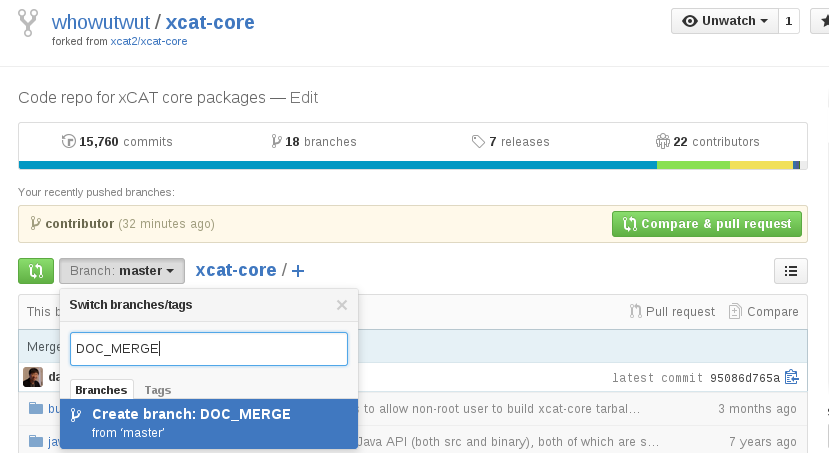Creating Branches¶
Note: To more easily keep the forked repository and upstream repositories in sync, we recommended that you keep your master branch free from changes and create branches to contain the changes in function you are working on.
Local Branches¶
Git branches are very light weight and easy to create. Simply use the git branch <branch_name> command.
Since we are using pull requests to merge changes back to the upstream project, you will need to have your changes committed to a branch on GitHub (calling this a “remote branch”) so that GitHub can detect differences and pull requests can be created.
Remote Branches¶
Reference articles: * http://www.gitguys.com/topics/adding-and-removing-remote-branches/
From GitHub¶
Under your repository, click on the Branch dropdown and type in a name for the new branch, then hit enter.
In the example below, creating a new branch off ‘master’ called
DOC_MERGE

Since we created the branch from the UI, a refresh needs to be done in order to see the new branch. Refresh by fetching from the origin repository:
$ git fetch origin Enter passphrase for key '/home/vhu/.ssh/github/id_rsa': From github.com:whowutwut/xcat-doc * [new branch] DOC_MERGE -> origin/DOC_MERGE
Show the remote branches:
git branch -r$ git branch -r origin/HEAD -> origin/master origin/large_cluster origin/master origin/DOC_MERGE <=== NEW BRANCH origin/sync upstream/master
From Command Line (CLI)¶
Create a branch:
$ git branch * master $ git branch skeleton $ git branch * master skeleton
Push the newly created branch to origin (on GitHub):
$ git push origin skeleton Enter passphrase for key '/home/vhu/.ssh/github/id_rsa': Total 0 (delta 0), reused 0 (delta 0) To git@github.com:whowutwut/xcat-doc.git * [new branch] skeleton -> skeleton
Verify that the branch is there by looking at the remote branches:
$ git branch -r origin/HEAD -> origin/master origin/master origin/skeleton <=== HERE IT IS upstream/master